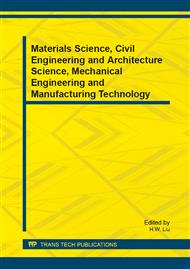p.3
p.9
p.14
p.18
p.22
p.26
p.30
p.36
The Structure and Thermal Properties of ZrAlYN Films Deposited by Magnetron Sputtering
Abstract:
ZrAlYN films were prepared by magnetron sputtering at various N2/Ar flow ratio. The structure, composition and thermal properties were characterized by X-ray diffraction, scanning electron microscopy and energy dispersive X-ray spectrum. The results show that the deposited ZrAlN and ZrAlYN films possessed a single NaCl-type solid solution phase. The ZrAlN film was (200) strongly predominated. The (111) peak was prominently increased in ZrAlYN films and thus the preferred orientation changed to (111) and (200) co-predomination. The crystallinity of ZrAlYN films was gradually degraded with enhanced N2/Ar flow ratio. Both ZrAlN and ZrAlYN films were exhibited a featureless fracture microstructure. The thickness of ZrAlYN films was consistently reduced due to more nitride produced on the surface of targets at higher N2/Ar flow ratio. The ZrAlYN films deposited at 1:5 N2/Ar flow ratio was proved to be the best oxidation resistance under annealing at 1000°C for 2h in air. As N2/Ar flow ratio increased, the oxidation resistance of films was inversely deteriorated due to the decreased yttrium content in films.
Info:
Periodical:
Pages:
9-13
Citation:
Online since:
January 2014
Authors:
Keywords:
Price:
Сopyright:
© 2014 Trans Tech Publications Ltd. All Rights Reserved
Share:
Citation:


